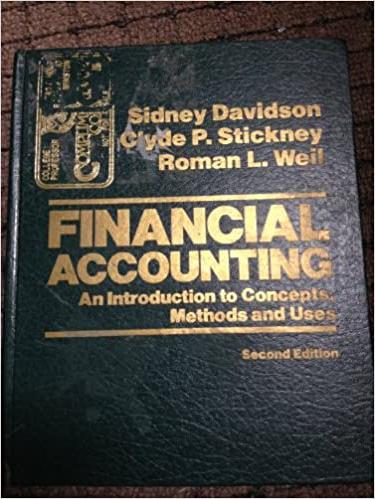Question
Analyze the effect of each transaction on the accounting equation. For example, if salaries of $500 were paid, the answer would be Decrease in stockholders'
-
Analyze the effect of each transaction on the accounting equation. For example, if salaries of $500 were paid, the answer would be "Decrease in stockholders' equity (expense) $500 and decrease in assets (cash) $500."
a. Performed consulting services for a client in exchange for $3,200 cash. Increase assets (cash)
- Increase assets (cash)
- Decrease assets (cash)
- Decrease stockholders' equity (revenue)
- increase stockholders' equity (revenue)
- decrease assets (cash)
- decrease stockholders' equity (revenue)
b. Performed consulting services for a client on account, $1,700.
- Increase assets (accounts receivable)
- Increase assets (cash)
- Decrease stockholders' equity (revenue)
- increase stockholders' equity (revenue)
- decrease assets (accounts receivable)
- decrease stockholders' equity (revenue)
c. Paid $30,000 cash for land.
- Increase assets (land)
- Decrease stockholders' equity (expense)
- Decrease assets (land)
- decrease stockholders' equity (expense)
- decrease assets (cash)
- increase liabilities (notes payable)
d. Purchased office supplies on account, $900.
- Increase assets (supplies)
- Decrease assets (supplies)
- Decrease liabilities (accounts payable)
- increase liabilities (accounts payable)
- decrease assets (supplies)
- decrease liabilities (accounts payable)
e. Paid a $2,500 cash dividend to stockholders.
- Increase assets (cash)
- Increase stockholders' equity (dividend)
- Decrease assets (cash)
- increase assets (cash)
- increase stockholders' equity (dividend)
- decrease stockholders' equity (dividend)
f. Paid $550 on account for supplies purchased in Transaction d.
- Increase assets (cash)
- Increase liabilities (accounts payable)
- Decrease assets (cash)
- increase assets (cash)
- increase liabilities (accounts payable)
- decrease liabilities (accounts payable)
g. Paid $800 cash for the current month's rent.
- Increase assets (cash)
- Decrease stockholders' equity (expense)
- Increase liability (payable)
- increase assets (cash)
- decrease assets (cash)
- decrease assets (cash)
h. Collected $1,500 from client in Transaction b.
- Increase assets (cash)
- Increase assets (accounts receivable)
- Decrease assets (cash)
- increase assets (accounts receivable)
- decrease assets (cash)
- decrease assets (accounts receivable)
i. Stockholders invested $20,000 cash in the business.
- Increase assets (cash)
- Decrease assets (cash)
- Decrease stockholders' equity (common stock)
- increase stockholders' equity (common stock)
- decrease assets (cash)
- decrease stockholders' equity (common stock)
2. Conceptual Connection: For Event d, what accounting principle did you use to determine the amount to be recorded for supplies?
- Conservatism principle
- Expense recognition principle
- Historical cost principle
2)
Kauai Adventures rents and sells surfboards, snorkeling, and scuba equipment. During March, Kauai engaged in the following transactions:
March Transactions: Mar. 2 Received $51,500 cash from customers for rental. 3 Purchased on credit ten new surfboards (which Kauai classifies as inventory) for $180 each. 6 Paid wages to employees in the amount of $9,200. 9 Paid office rent for the month in the amount of $1,000. 12 Purchased a new Ford truck for $40,800; paid $1,000 down in cash and secured a loan from Princeville Bank for the $39,800 balance. 13 Collected a $1,050 account receivable. 16 Paid an account payable in the amount of $950. 23 Borrowed $10,000 on a 6-month, 8% note payable. 27 Paid the monthly telephone bill of $185. 30 Paid a monthly advertising bill of $1,550. Required: Prepare a journal entry for each of these transactions. CHART OF ACCOUNTS Kauai Adventures General Ledger ASSETS 111 Cash 121 Accounts Receivable 122 Notes Receivable 123 Supplies 124 Prepaid Insurance 125 Prepaid Rent 126 Inventory 131 Land 132 Buildings 133 Equipment 134 Furniture 135 Trucks 139 Accumulated Depreciation LIABILITIES 211 Accounts Payable 212 Notes Payable 213 Income Taxes Payable 214 Wages Payable 215 Utilities Payable
216 Insurance Payable 217 Interest Payable 218 Rent Payable 219 Unearned Service Revenue 231 Bonds Payable EQUITY 311 Common Stock 321 Retained Earnings 331 Dividends REVENUE 411 Sales Revenue 412 Service Revenue 413 Interest Income EXPENSES 511 Cost of Goods Sold 512 Advertising Expense 513 Supplies Expense 514 Utilities Expense 515 Rent Expense 516 Insurance Expense 517 Repairs and Maintenance Expense 521 Wages Expense 531 Interest Expense 532 Depreciation Expense 533 Income Taxes Expense
Step by Step Solution
There are 3 Steps involved in it
Step: 1

Get Instant Access to Expert-Tailored Solutions
See step-by-step solutions with expert insights and AI powered tools for academic success
Step: 2

Step: 3

Ace Your Homework with AI
Get the answers you need in no time with our AI-driven, step-by-step assistance
Get Started


